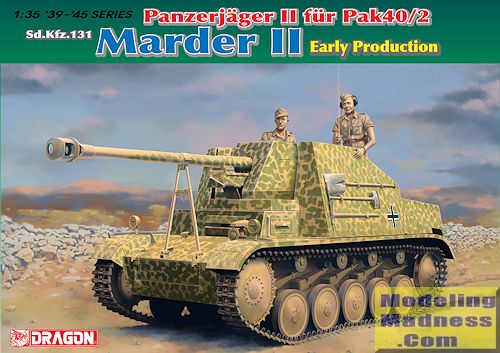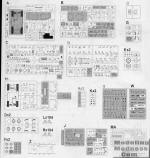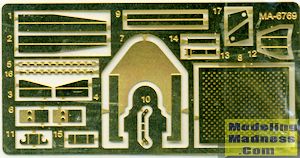
| HISTORY |
| KIT #: | 6769 |
| PRICE: | $76.00 SRP |
| DECALS: | Two options |
| REVIEWER: | Scott Van Aken |
| NOTES: | Includes a small p.e. fret and individual track links. |

| HISTORY |
During the very first days of Operation Barbarossa, the invasion of the Soviet Union, the Germans were shocked to encounter Soviet T-34 medium tanks and KV heavy tanks. Although the Wehrmacht succeeded in most operations due to superior tactics, morale, and supply, it had few anti-tank weapons capable of successfully engaging these vehicles at normal ranges. An urgent need arose for a more mobile and powerful anti-tank weapon than the existing towed anti-tank guns or tank destroyers like the Panzerjäger I.
Among a series of solutions, it was decided to use light tanks like the Panzer II and captured vehicles like the Lorraine Schlepper as the basis for makeshift tank destroyers. The result was the Marder series, which were armed with either the new 7.5 cm Pak 40 anti-tank guns or captured Soviet 7.62 cm F-22 Model 1936 field guns, large numbers of which had been acquired early in the war.
Production
The Marder II came in two major versions. The first version Marder II (Sd.Kfz. 132) was based on the light Panzer II Ausf. D/E andFlammpanzer II chassis with Christie suspension. It was armed with captured Soviet 7.62 cm guns, re-chambered to accept German 7.5 cm Pak 40 ammunition, which improved its penetrative capabilities. These early Marder IIs had a very high silhouette (2.60 m high), thin armor of only 30 mm (front) and 10 to 15 mm (sides). There was no armour on the top or rear, leaving the crew with very little protection. Alkett and Wegmann produced 201 Marder II (Sd. Kfz. 132) from early 1942 to early 1943.
The second version Marder II (Sd.Kfz. 131) was based on Panzer II Ausf. A to C removed from active service but later also newly produced Ausf. F chassis were used. This Marder II had a redesigned (widened) fighting compartment and used the German 75 mm Pak 40 anti-tank gun. The silhouette was lowered by about 40 cm to 2.20 m, but the armor was thin and the compartment was open to the top and rear, as in Sd. Kfz. 132. FAMO, MAN and Daimler-Benz produced 576 Marder II (Sd.Kfz. 131) conversions from June 1942 to Mid 1943. 75 more were converted (probably by FAMO only) from mid 1943 to early 1944 when the last Panzer IIs were taken out of active service.
Combat history
The various Marder IIs fought on all fronts of the war, mainly at the Eastern Front.
The Marder IIs were used by the Panzerjäger Abteilungen of the Panzer divisions of both the Wehrmacht and the Waffen SS, as well as several Luftwaffe units.
The Marder's weaknesses were mainly related to survivability. The combination of a high silhouette and open-top fighting compartment made them vulnerable to indirect artillery fire, shrapnel, and grenades. The armor was also quite thin, making them vulnerable to enemy tanks or infantry.
The Marders were not assault vehicles or tank substitutes; the open top meant that operations in urban areas or other close-combat situations were very risky. They were best employed in defensive or overwatch roles. Despite their weaknesses they were much more effective than the towed antitank guns they replaced.
| THE KIT |
 Much of the parts count of 650 pieces is dedicated to the suspension on this kit. In addition to all the separate suspension bits, you have individual track links for each side of the vehicle. As the instructions state 'Make 99 for each side'. As it is also an open topped vehicle, it somes with a relatively complete interior. This includes a full transmission, driver's compartment, and fighting compartment with all the various racks for sheels and for the defensive machine guns.
Much of the parts count of 650 pieces is dedicated to the suspension on this kit. In addition to all the separate suspension bits, you have individual track links for each side of the vehicle. As the instructions state 'Make 99 for each side'. As it is also an open topped vehicle, it somes with a relatively complete interior. This includes a full transmission, driver's compartment, and fighting compartment with all the various racks for sheels and for the defensive machine guns.
You are also supplied with a nearly complete PaK 40 anti-tank gun save for the wheels and trails. There are various hatches and viewing ports that can be modeled open or closed. This includes the engine compartment hatches though there is no engine supplied with the kit. The gun has limited elevation and azimuth capabilities, just like the real vehicle.
Markings are supplied for two vehicles, both in overall tan with splotches of green and/or brown such as shown on the box art vehicle. There is a small decal sheet that supplies just insignia. A previously kitted Marder II came with an aluminum gun barrel, but not this particular kit. Photo etch is used sparingly with the largest piece being a muffler guard.
| CONCLUSIONS |
This kit of the Marder adds to Dragon's inventory of German vehicles, which must exceed several hundred by this time. It is not a quick build, but provides a level of detail that many modelers demand from their kits. Of course, this comes at a price and these kits are no longer in the $50 retail arena.
| REFERENCES |
http://en.wikipedia.org/wiki/Marder_II
May 2015
Thanks to www.dragonmodelsusa.com for the preview kit. You can find this kit at your favorite hobby shop or on-line retailer.If you would like your product reviewed fairly and fairly quickly, please contactthe editor or see other details in the